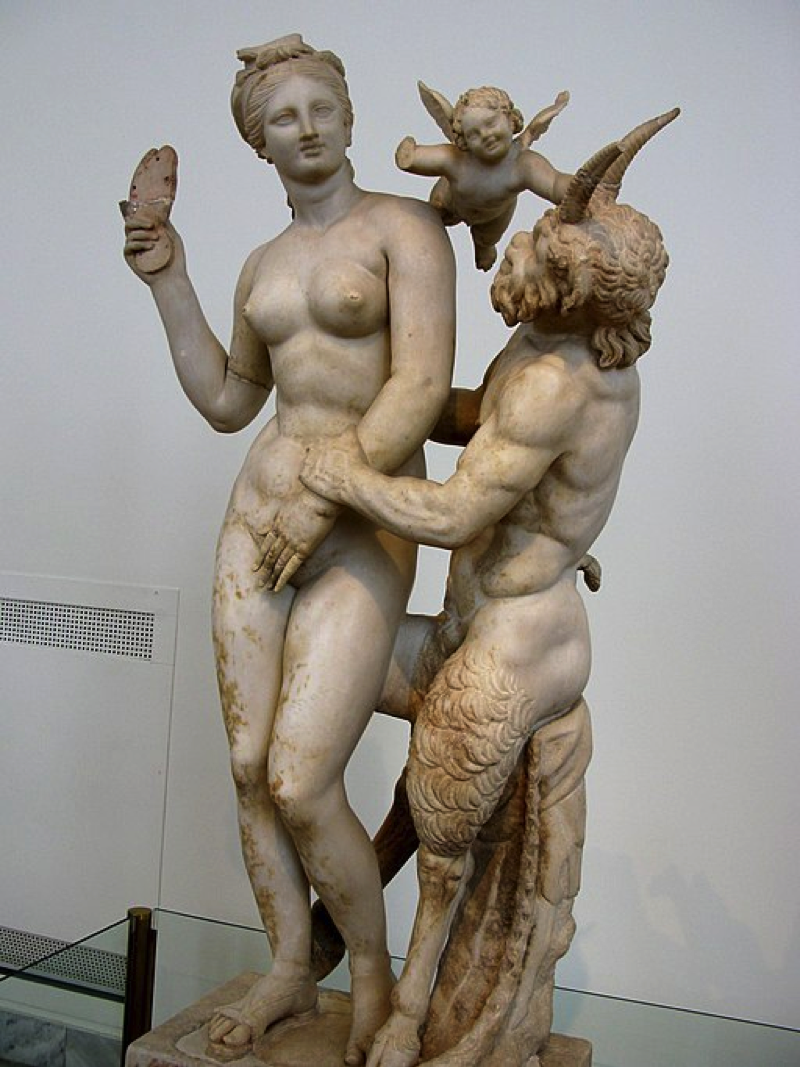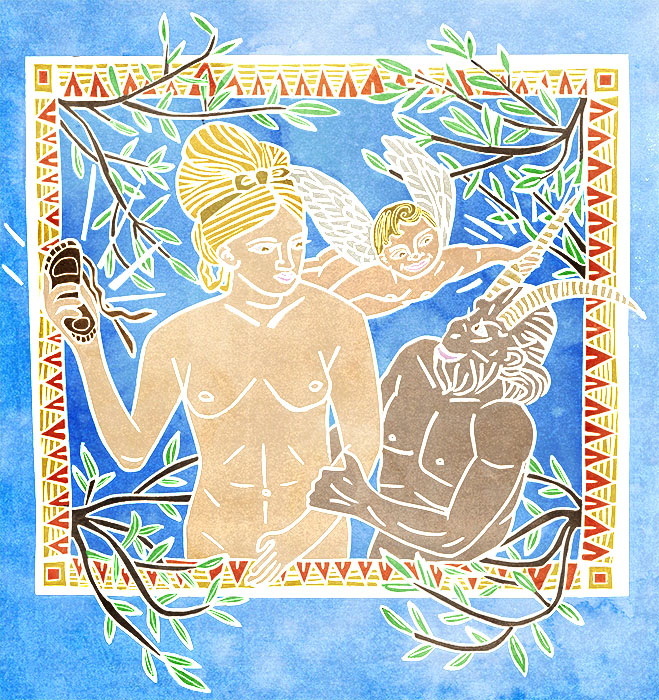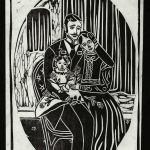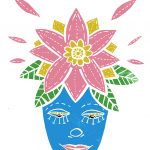Aphrodite, Pan and Eros (National Archaeological Museum of Athens).
The intriguing statue of Aphrodite, Pan and Eros is housed at the National Archaeological Museum in Athens.
Background
Aphrodite was a Greek goddess of ancient times who was linked with beauty, love and sexuality.
Symbolic items related to Aphrodite are roses, doves, sparrows, swans and a shrub called myrtle. These produce a fragrant essential oil. Aphrodite had a cult following which was mainly based in parts of mainland Greece and Cyprus. The festival which celebrated her was called the Aphrodisia. Although Aphrodite was married to Hephaestus who was the God of metalworking and blacksmiths, she managed to have several affairs. These affairs included Ares, the God of War, Anchises, a human shepherd and Adonis also a human shepherd (she was also his surrogate mother). That’s just the A’s!
Pan was the God of shepherds, the wilderness and rustic music. He also was a friend to the female nymphs who were minor godlike creatures. Each had their own responsibility e.g. the beaches, springs, waterfalls, meadows etc. The male equivalent of a nymph was called a Satyr. As Pan was the God of nature, he was worshipped in caves and grottos, not temples. His parentage is not established. One myth is that his mother slept with 108 potential suitors, this might be why his name is Pan which in Greek means “all”.
Eros was the God of love and sex and the son of Aphrodite and Ares. He was also one of the primordial Gods; one of the Gods who made the universe. In ancient Greek times he was always shown as a sexy young man with great artistic ability. The roman equivalent of Eros was Cupid who was a cubby child who kept interfering in people’s relationships trying to encourage love. Eros could also give male lovers special qualities e.g. strength and loyalty and so he is connected to homosexual lovers.
The Statue

(Picture attributed to Tilemahos Efthimiadis and uploaded from Wikimedia Commons, the free media repository)
This statue of Aphrodite, Pan and Eros is housed at the National Archaeological Museum in Athens (artist unknown). It is 1.5 metres high and made from Parian Marble. It dates from about 100 BC and was found on one of the Greek islands. There is an inscription on the bottom of the statue saying it was made as a gift to the Gods to benefit the family of the person who commissioned it. It was thought to have been housed in the equivalent of a businessman’s club.
It is an interesting piece as the female is Aphrodite, but she is holding a shoe in her right hand, something you do not normally see in ancient sculptures of her. Next to her is Pan, a Faun who is the God of Shepherds and who was known as a “party boy”. He is resting against a tree trunk with an animal skin on it and his shepherd’s stick is lying on the ground. Above them is Eros who is the son of Aphrodite and the God of Love. In this sculpture Eros is represented as a child.
Looking at the scene it appears that Aphrodite is covering her genitals with her left hand and Pan appears to be trying to force her hand away but all the while looking at her face in a pleading way. His right arm is across Aphrodite’s back and his right leg crosses her legs at the back. This looks like he intends to slowly grasp her and there is a possibility of violence. The lecherous Pan is obviously hoping to seduce Aphrodite, but Aphrodite seems to be putting up a fight and threatening him with her shoe. Eros, her son, is also trying to stop this advance upon his mother by trying to separate them.
It is interesting however, to hear other people’s opinions about what is actually happening. Most females I have asked have the same opinion as mine (I’m female) but some men have a different view. It has been said by them that Aphrodite doesn’t appear to be angry in fact she has a faint smile on her face and her body language is quite relaxed. She appears to be teasing Pan. Also why is her son Eros, the God of Love, smiling when he too should be angry? He is not making too much effort in pushing Pan away and it was also suggested that Eros’s smile means he is anticipating a fun time ahead for all parties! (I found this suggestion difficult to understand as Aphrodite is Eros’s mother, but I suppose this fits in with most Greek myths!).
Observing how Aphrodite is so beautiful and sophisticated and completely out of Pan’s league, I think she is warning him off in a polite way, like: “in your dreams Pan!” and Eros is almost laughing at his futile attempt to have sex with her!
The statue itself was sculptured during the late Hellenistic period. This period immediately followed the Classical period when Greek statues still maintained a standard of idealistic beauty.
My version in linocut print

I have prepared, above, an illustration using the linocut printmaking technique. This is my way of paying homage to this excellent ancient Greek statue.



